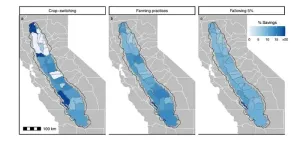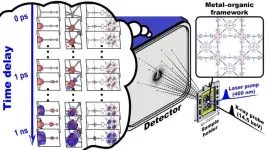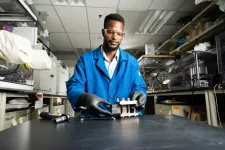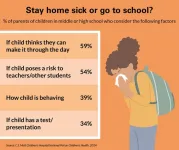(Press-News.org) (Santa Barbara, Calif.) — While Hollywood and Silicon Valley love the limelight, California is an agricultural powerhouse, too. Agricultural products sold in the Golden State totaled $59 billion in 2022. But rising temperatures, declining precipitation and decades of over pumping may require drastic changes to farming. Legislation to address the problem could even see fields taken out of cultivation.
Fortunately, a study out of UC Santa Barbara suggests less extreme measures could help address California’s water issues. Researchers combined remote sensing, big data and machine learning to estimate how much water crops use in the state’s Central Valley. The results, published in Nature Communications, suggest that variation in efficiency due to farming practices could save as much water as switching crops or fallowing fields.
“There’s an opportunity for less obtrusive methods of saving water to be more important than we originally thought,” said lead author Anna Boser, a doctoral student at UCSB’s Bren School of Environmental Science & Management. “So we might not have to make as many changes in land use as we originally thought.”
California’s fertile soils and Mediterranean climate enable farmers to cultivate high-value crops that just aren’t viable in the rest of the country. Over a third of the country’s vegetables, and nearly three-quarters of fruits and nuts, are grown in California, according to the state’s Department of Food and Agriculture.
But many of these crops are quite thirsty. Agriculture accounts for around 80% of water used in California, explained co-author Kelly Caylor, a professor at the Bren School. “Declining groundwater levels and a changing climate put pressure on the availability of irrigation water, making it critical to determine how we can ‘do more with less.’”
In 2014, Sacramento passed the Sustainable Groundwater Management Act (SGMA) to secure California’s water resources. SGMA mandates that every groundwater basin in the state must be sustainable by 2040. Each basin created a local agency tasked with developing a plan to meet this goal. Mostly, that means ensuring that we don’t pump more water out of the ground than what seeps in. We will need to reduce total groundwater use by 20% to 50% by 2040, depending on the basin, Boser said. But to accomplish this, we need an idea of how much water farms use, and what fraction of that actually makes it to crops.
Modeling water use
Scientists have a variety of methods to estimate the amount of water ascending from the Earth’s surface to the atmosphere due to evaporation and transpiration through plant leaves. Notably, evaporation cools things down. “When we get hot, we sweat to cool off. The Earth does something similar,” Boser said. Scientists look at how warm the ground is and see how much energy it’s getting from sunlight and the atmosphere. If the ground is cooler than expected, it means some of that energy was used to turn water into vapor, which cools down that spot.
An evapotranspiration database called OpenET became publicly available in early 2023. It provides satellite-based evapotranspiration estimates for the western United States. But Boser was interested in the water being used specifically by crops. So, she compared transpiration in fallowed fields to active fields across the Central Valley. Subtracting evapotranspiration in fallow fields from total evapotranspiration yields the amount of water that crops are actually consuming.
Unfortunately for Boser, farmers don’t fallow fields randomly. Often they’ll take their lowest-yielding fields out of production. That creates systematic differences between fallowed and cultivated fields, which could skew Boser’s analysis. So, she created a machine-learning model to conduct a weighted comparison between active and fallowed land, accounting for factors like location, topography and soil quality.
She trained the model on 60% of the areas and tested its results on 30%, fine tuning the algorithm until its predictions matched the actual conditions in these fields within 10 milliliters per square meter per day, on average. Now confident in her model, she applied it to the rest of California’s Central Valley.
Encouraging results
Crop type only explained 34% of the variation in water consumption. “What that means is maybe we’re overlooking some other ways that we could save water,” Boser said. She continued to investigate the model, controlling for factors like location, topography, local climate, soil quality and orchard age (when applicable). Ultimately, a full 10% of crop transpiration could be saved if the top 50% of water users reduced their water consumption to match that of their median-consuming neighbors. Boser attributes these savings to differences in “farming practices.”
Now, 10% might not sound like a lot, but it’s comparable to a number of other interventions. The authors also estimated the effect of switching crops. If the same 50% of farmers switched to the median water-intensive crops for their area, agricultural evapotranspiration would drop by 10%.
Meanwhile, if the state took the top 5% most water-hungry fields out of production, the model says agricultural evapotranspiration would drop by, you guessed it: 10%. This suggests that addressing inefficiencies in farming practices could save as much water as switching crops or taking fields out of cultivation.
To be fair, the results from fallowing would affect only 5% of cultivated land, as opposed to 50% for crop changes and improved farming practices. “We’re probably going to have to fall back on fallowing at least a little bit,” Boser said, “but hopefully not as much as we were originally expecting.”
The authors want to figure out what practices farmers are using that account for the 10% differences in crop water usage. Some examples include mulching, no-till planting, using drought-tolerant varietals, and deficit irrigation — where you provide less water than the crop could theoretically consume. Deficit irrigation already yields good results in viticulture, where vintners find it can improve the quality of wine.
Changing irrigation practices could also help reduce water use. Irrigation efficiency accounts for the fraction of water a farm uses that actually gets consumed by crops. Inefficiencies include leakage, weed growth and evaporation in transport and in the field. These weren’t within the scope of Boser’s model, which only considers transpiration by the crops themselves. Inefficiencies happen before the water even gets to the plants.
According to Boser, up to 60% of the water a farm uses actually passes through the roots of its crops. Clearly there’s plenty of potential gains in this area, though it isn’t clear what efficiency is actually attainable, she said. “Irrigation efficiency is actually quite poorly understood.”
Better characterizing this is on the team’s to-do list. They hope to identify the causes of irrigation inefficiencies, quantify the efficiencies of different types of irrigation, and learn how climate and geography affects irrigation efficiency. All this will require collecting empirical data.
California is at a critical crossroads in water management. For the first time in its history, the state is putting in place regulations that require substantial reductions in groundwater extraction, including in regions where livelihoods depend on thirsty agricultural production.
“This paper uses novel, data-driven methods to show that, contrary to popular belief, there is large potential to cut water use in California agriculture without fallowing fields,” said co-author Tamma Carleton, an assistant professor at UCSB’s Bren School. “This raises the possibility that the state can continue its role as an agricultural powerhouse while also sustainably managing an essential natural resource.”
END
Small changes can yield big savings in agricultural water use
California agricultural could potentially avoid more extreme water-saving measures as it faces challenges from climate change and water scarcity
2024-03-25
ELSE PRESS RELEASES FROM THIS DATE:
Humans pass more viruses to other animals than we catch from them
2024-03-25
Humans pass on more viruses to domestic and wild animals than we catch from them, according to a major new analysis of viral genomes by UCL researchers.
For the new paper published in Nature Ecology & Evolution, the team analysed all publicly available viral genome sequences, to reconstruct where viruses have jumped from one host to infect another vertebrate species.
Most emerging and re-emerging infectious diseases are caused by viruses circulating in animals. When these viruses cross over from animals into humans, a process known as zoonosis, they can cause disease outbreaks, epidemics and pandemics such as Ebola, flu or Covid-19. Given the enormous impact ...
Filming ultrafast molecular motions in single crystal
2024-03-25
Understanding the behavior of matter is crucial for advancing scientific fields like biology, chemistry, and materials science. X-ray crystallography has been instrumental in this pursuit, allowing scientists to determine molecular structures with precision. In traditional X-ray crystallography experiments, a single crystal is exposed to X-rays multiple times to obtain diffraction signals. This poses a problem, where the sample has its structure altered or damaged by X-ray exposure.
In recent years, advances in technology have allowed for the development of “time-resolved serial femtosecond crystallography” (TR-SFX). In serial ...
Better phosphorus use can ensure its stocks last more than 500 years and boost global food production - new evidence shows
2024-03-25
More efficient use of phosphorus could see limited stocks of the important fertiliser last more than 500 years and boost global food production to feed growing populations.
But these benefits will only happen if countries are less wasteful with how they use phosphorus, a study published today in Nature Food shows.
Around 30-40 per cent of farm soils have over-applications of phosphorus, with European and North American countries over-applying the most.
The global population is due to hit nearly 10 billion by 2050 and it is estimated that to feed ...
New all-liquid iron flow battery for grid energy storage
2024-03-25
RICHLAND, Wash.— A commonplace chemical used in water treatment facilities has been repurposed for large-scale energy storage in a new battery design by researchers at the Department of Energy’s Pacific Northwest National Laboratory. The design provides a pathway to a safe, economical, water-based, flow battery made with Earth-abundant materials. It provides another pathway in the quest to incorporate intermittent energy sources such as wind and solar energy into the nation’s electric grid.
The researchers report ...
Gene discovery offers new hope for people living with chronic skin disease
2024-03-25
Scientists from The Australian National University (ANU) have discovered a gene mutation is responsible for causing psoriasis – a chronic inflammatory skin disease that causes patients to develop red, scaly and itchy patches across their body.
According to ANU researcher Dr Chelisa Cardinez, if two copies of this mutated gene (known as IKBKB) are present, patients with psoriasis may go on to develop psoriatic arthritis, leaving them with joint pain, stiffness and swelling. Thanks to the world-first discovery from ANU, scientists now know what causes the progression from a skin-only disease to a skin and joint disease.
It’s hoped the findings will lead ...
What factors contribute to differences in cervical cancer screening in rural and urban community health centers?
2024-03-25
In the United States, community health centers (CHCs) mainly serve historically marginalized populations. New research reveals that both before and during the COVID-19 pandemic, females receiving care at rural CHCs were less likely to be up to date with cervical cancer screening than those in urban CHCs. Factors associated with these differences included the proportion of patients with limited English proficiency and low income, as well as area-level unemployment and primary care physician density. The findings are ...
2 in 3 parents say their adolescent or teen worries about how sick days may impact grades
2024-03-25
ANN ARBOR, Mich. – Many parents struggle deciding whether their middle or high school aged child should stay home from school if they don’t feel well, a new national poll suggests.
Among top factors: how their adolescent or teen is behaving due to symptoms and if they can get through a school day, the risk that they’re contagious and whether the student will miss a test, presentation or after school activity.
One in five parents also consider if their child needs a mental health day, according to the University of Michigan ...
Physician work hours, especially for male doctors, have declined since 1987
2024-03-25
Physicians in Canada, especially male physicians, are working fewer hours than they did 3 decades ago, and these long-term trends must be considered in workforce planning, according to new research in CMAJ (Canadian Medical Association Journal) https://www.cmaj.ca/lookup/doi/10.1503/cmaj.231166.
"Canadian physicians' work hours, crucial for health care access and planning, have seen a long-term decline, especially among male and married physicians, suggesting a shift towards better work–life balance," said Dr. Boris Kralj, Department of Economics, Centre for Health Economics & Policy Analysis, McMaster University, Hamilton, Ontario.
Using ...
RaDPi-U: A fast and convenient drug screening with urine samples
2024-03-25
Drugs, both legal and illegal, cause millions of cases of severe intoxication every year, leading to health complications and even fatalities. Often, they are also implicated in violent and sexual harassment crimes, as well as accidents. Obtaining detailed information about the drugs consumed by a criminal or victim is often challenging. Forensic professionals rely on drug screening techniques performed on biological samples, such as blood or saliva, to gather crucial evidence.
Today, various types of practical drug screening methods exist, each with their own unique advantages ...
Sweeping review reveals latest evidence on the diagnosis, treatment, and monitoring of ADHD
2024-03-25
Hundreds of studies are published each year on attention deficit hyperactivity disorder (ADHD), but more work is needed to ensure those findings improve lives.
With input from expert stakeholders across the field, researchers at the Southern California Evidence Review Center, part of the Keck School of Medicine of USC, have synthesized the latest insights so that they can ultimately inform clinical practice. Broadly, they found that both medications and psychosocial treatments work for treating ADHD and that children with the condition can and do get better.
“We have more research than ever on ADHD, but we need ...
LAST 30 PRESS RELEASES:
Chicago health information leader recognized for raising CPR readiness and blood pressure awareness
The Intimate Animal, a new book from Kinsey Institute Executive Director Dr. Justin Garcia
When blue-collar workers lose union protection, they try self-employment
New video dataset to advance AI for health care
MEA-based graph deviation network for early autism syndrome signatures in human forebrain organoids
New modeling approach sheds light on rare gut disease
Study documents potentially hazardous flame retardants in firefighter gear
Can certain bacteria regulate aging of the immune system and its related alterations?
AI model helps diagnose often undetected heart disease from simple EKG
There are fewer online trolls than people think
Cell membrane fluctuations produce electricity
Jeonbuk National University study shows positive parenting can protect adolescents against self-harm
Surface-engineered ZnO nanocrystals to tackle perfluoroalkyl substance contamination
This new understanding of T cell receptors may improve cancer immunotherapies
A new fossil face sheds light on early migrations of ancient human ancestor
A new immunotherapy approach could work for many types of cancer
A new way to diagnose deadly lung infections and save lives
40 percent of MRI signals do not correspond to actual brain activity
How brain-inspired algorithms could drive down AI energy costs
Gum disease may be linked to plaque buildup in arteries, higher risk of major CVD events
Contrails are a major driver of aviation’s climate impact
Structure of dopamine-releasing neurons relates to the type of circuits they form for smell-processing
Reducing social isolation protects the brain in later life
Keeping the heart healthy increases longevity even after cancer
Young adults commonly mix cannabis with nicotine and tobacco
Comprehensive review illuminates tau protein's dual nature in brain health, disease, and emerging psychiatric connections
Book prepares K-12 leaders for the next public health crisis
Storms in the Southern Ocean mitigates global warming
Seals on the move: Research reveals key data for offshore development and international ecology
Sports injuries sustained during your period might be more severe
[Press-News.org] Small changes can yield big savings in agricultural water useCalifornia agricultural could potentially avoid more extreme water-saving measures as it faces challenges from climate change and water scarcity







